Daniel Buttars
22 September 1858 – 10 January 1916
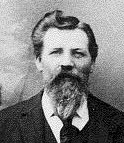 |
Each man, woman, and child that made the trek brought with them their own story and left behind their own legacy. On October 24, 1854 the forty three wagons of the William Empey Company arrived in Salt Lake City. Among the members of that company was a thirty one year old Scottish immigrant by the name of David Buttars with his wife, Margaret, and two children; Marjory age four, and Bethea age three. Their infant son, David, was buried at sea while crossing the Atlantic Ocean. After three months in Salt Lake City, they settled in Lehi where David worked as a shoemaker and did a little farming. Lehi is the northern most community in Utah County, just south of Salt Lake.
While living in Lehi, four more children were born to David and Margaret.
The first being John Spaulding on May 23, 1856. Daniel Buttars
entered his own story on September 22, 1858, followed by his brother,
Robert Souter on April 6, 1861. When Daniel was seven years old, his
sister. Margaret was born on August 5, 1863. Sadly, five days later,
on August 10th his mother died from complications during
the delivery. The baby also died on August 21st Both
Margarets were buried in the Lehi city cemetery.
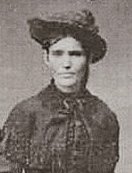
Margaret Spaulding
Buttars
The family suffered many hardships due to the loss of their mother and the shortage of food and clothing which was so prevalent among the early settlers of Utah. A little over three years later, David met Sarah Keep, who had arrived in Salt Lake City from England in October of 1866. Sarah had a daughter, Lucy Francis (26 May 1866), from a previous marriage. Immediately on their arrival in Utah, they went to Lehi to stay with Sarah's sister.
David and Sarah were married on December 16, 1866 in the Endowment House in Salt Lake City. David adopted Lucy, and Sarah raised his children as if they were her own. Their first child that they had together, Sarah Isabell, was born in Lehi on April 16, 1868 but died three months later on July 14th.
When Daniel was ten years old, the family moved to Clarkston from Lehi in October 1868.
Clarkston, which is is tucked away in a secluded corner of the valley, is thirteen miles north and thirteen miles east of Logan, and five miles south of the Idaho boarder.
In the fall of 1864 a group of twelve families under the direction of Israel Clark, for whom Clarkston was named, were the first to settle the area. By 1866 several families had established their homes in Clarkston to the dismay of the Shoshone Indians who claimed the land west of the Bear River. The Indians set up camp on City Creek, just outside of town, and demanded beef and flour from the settlers. Brigham Young determined that it was better to feed the Indians than fight them. But when their food supplies dwindled they were unable to meet the demands of the Indians. It was advised that they abandon their homes and relocate to Smithfield.
The following spring, the pioneer families returned to their farms and built a fort. They formed a militia consisting of a horse company and and an infantry company to keep the Indians in check. During the trouble, one Indian was killed. Once peaceful and friendly relations were established with the Indians, Clarkston once again continued to grow as more settlers arrived, including David Buttars and his family. Soon after moving to Clarkston, Daniel's sister, Elizabeth, was born June 9, 1869 in Clarkston.
1871 was a difficult year in the settlement as the Indians became a menace again. It was during this time that Daniel's brother Charles William was born on June 15, 1871. As spring passed into summer, the crops were just getting established. That summer the crickets devoured their crops three times. Three times the seagulls descended on the the fields and devoured the crickets. The Crickets were so bad that Daniel (who was twelve years old) and his brothers and sisters each took the ends of a rope and drug it over the grain to drive the crickets off for the night to spare the grain. Three times they replanted their crops and in the fall, his father harvested a record crop of 1,300 bushels of wheat.
During the 1870s the hardships of pioneer life began to ease. New homes were built, accompanied by barns, granaries, and gardens. A woolen mill was erected. And a rock meetinghouse was completed and in the 1880s a two room schoolhouse and built. Life was good in Clarkston. During this time Daniel was growing into a young man. Three more brothers and a sister were born while the family was living in the fort; Thomas James (October 13, 1873), David Alexander (December 14, 1875), Joesph James (February 26, 1878), and Mary Janet (June 30, 1880).
By 1880, most of the Indian troubles were over. The family moved out of the fort and built another two room house on their farm north of Clarkston. David and Sarah had one more child, Emma Jane who was born on October 8, 1883. During this time, Daniel worked on his father's farm and on the railroad. When he was twenty-one years old, his father gave him a team of horses, a wagon, a new pair of homemade overalls, and a quilt. Daniel moved out of the home and went to live with his brother John and his wife.
Being a small community, everyone knew everyone else. At some point in time, Daniel became aware of Emma Gover, the daughter of Maurice and Sarah Tucker Gover. Awareness turned into interest, which lead to courtship, which resulted in marriage.
Daniel, Emma, and her mother made the trip to Salt Lake in a wagon drawn by a team of horses. It took them three days to drive from Clarkston to Salt Lake City. They stayed with friends and relatives along the way. Emma's mother accompanied them to see her daughter be married. While in Salt Lake, they were guests of the Cook family, who were relatives of the Govers. Daniel and Emma were married in the Endowment house on December 27, 1883 by Daniel H. Wells, who at the time was the Second Counselor in the First Presidency. At the time of their marriage, Daniel was twenty five and Emma had just turned nineteen.
Daniel and Emma built their first home in Clarkston. It was a one room
house, built on block number 16 in the northwest part of town. They
later moved across the street into a two room log house on block
number 15.

Daniel and Emma Buttars and family
- About 1887. Daniel is holding Margaret
and Daniel David is standing in front
of Emma.
Daniel became a very successful stockman and farmer. He took every opportunity to improve himself financially. He moved his wife and family about two miles west of Clarkston to City Creek where he homesteaded one hundred and sixty acres of land. To homestead land, one had to live on the land at least six months of each year, for five years.
The land was covered with sagebrush, chock cherry and other kinds of trees. It took a lot of hard hand labor to clear them away. Daniel cleared a little more each year and planted it to grain. He walked behind the hand plow and harrows to prepare the ground for planting.
Another adventure and project during Daniel's life included a cattle ranch in Canada. His half brother Jim (Joesph James) had a made a trip up to Canada. On his return, Daniel and Dan Costley asked him what he thought of the country and if he thought it would be a good place for a cattle ranch. Jim told them that it was ideal, except the climate, but there was plenty of grass for pasture and to cut for winter feed.
The three of them went up that fall and bought a ranch. They moved their cattle up the next spring. That fall a big snow storm moved in. They rounded up their cattle and put them in sheds and turned their saddle horses into the hay stacks. They thought they were ready for the storm. But to their surprise, the next morning they found one of their horses had frozen to death in a snow drift and their cattle all gone. When they found them, they were fifty miles away. The Canada project wasn't as successful as he expected it to be. Daniel traded his share of the cattle and the ranch to Mr. Costley for the farm he owned north and west of Clarkston.
On the property was a house with three rooms and an unfinished attic,
where some of the older boys slept. To reach the attic, they had to
use a ladder attached to the outside of the house. Later a platform
and stairs were installed.
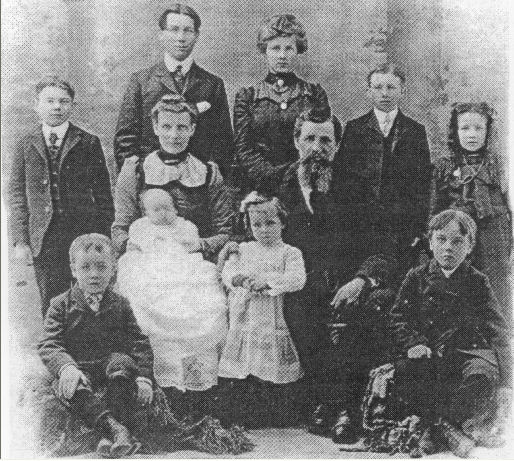
Daniel and Emma Buttars and family- About 1904. Standing; Orson,
Danny, Margaret, Melvin, and Maybell. Seated: Gover, Emma holding
Archulious, Daniel with Hattie, and Iraw.
Danielmade a reservoir to supply water for the animals. He also installed a hydrant close to the house which was an unusual convenience at that time for a farm house. Most people had to haul their water in.
He was a member of the Prayer Circle Group that was organized in Clarkston by Bishop John Jardine on the 23 June 1901. Permission for the organization came from the First Presidency of the Church through the President of the Logan Temple. They met twice each month in an upstairs room in the home of David Buttars, Daniel's father. Thanks was given. The mercies and blessings from God where recognized. A petition for temporal and spiritual blessings was invoked. And a restoration of health for the sick was asked for.
Daniel and Emma were the parents of ten children; Daniel David (November 20, 1884), Margaret Sarah (August 25, 1886), Melvin Henry (December 23, 1888), Orson Morris (April 18, 1891), Maybell (May 3, 1893), Gover (December 10, 1895), Iraw (May 13, 1898), Hattie Bethea (November 17, 1900), Archulious (November 6, 1903), and Wallace Spaulding (July 25, 1906).
By the time the youngest was born, the older children had grown up. Danny married Margaret Kent on June 19, 1906. Margaret married James H. Jardine on April 17, 1907. Melvin served a mission in New Zealand from October 1, 1910 until December 20, 1912.
On the same day that Wallace was born, work began on a large house located on the same property as the home they were living in at the time. The contractors worked on it all of that summer and the next. All of the material to build the house was hauled from Logan by horse drawn wagons. The rocks for the foundation were hauled from the surrounding area. The house was completed in 1907 and the family moved in for Christmas.
The new, two story house featured indoor plumbing which included a
kitchen sink, bathtub, and toilet. There was not yet a central water
system in Clarkston. To supply water for the house, a five hundred
gallon water tank was installed on the second floor. It took about an
hour and half each morning to fill the tank with a hand pump. The
tank generally lasted through the day. It was the first house in
Clarkston with a bathtub and a toilet in it. Many people came from
all over just to see it.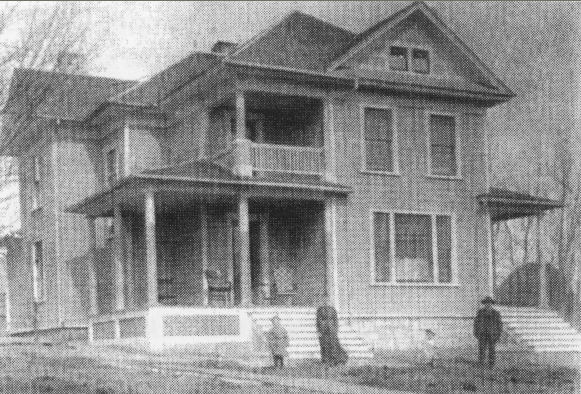
The Daniel Buttars home
At first, kerosene lamps were used to light the eight rooms until about 1913, when gas lights were installed. A tank supplied the gas. The lights were pressurized by a hand pump. The gas lights were not very successful and were dangerous. When electricity came to Clarkston in 1916, it was quite a chore to wire the the two story house.
The kitchen, dining room, parlor, and two bedrooms were on the main floor. A beautiful hand carved banister graced the stairs that led to five more bedrooms on the top floor. All new furniture, tables, chairs, beds, window curtains, blinds, etc. were purchased for the new home.
Daniel was very hospitable – at Emma's expense. Everyone who came along were invited to come in for dinner or even spend the night. The smaller children were often put to bed on the floor, so the guests could occupy their beds. Their horses were also taken care of. In fact, so many people stayed there that their home was referred to as The Mountain View Hotel. One had only to look out the back door to see the the beautiful mountains to the west, especially at sunset to appreciate the name.
Daniel was one of the men in Clarkston to whom the people looked to when
they wanted an improvement made. He and Andrew Heggie were the two
men that people wanted to head the project. They laid out the channel
for Birch Creek. In 1908, Daniel was also involved with a water works
system. Deep trenches began to worm their way through town. Wooden
pipes were installed bringing cool, clear water to each home at the
twist of a tap. It was an appreciated improvement over the old pumps
and wells and it opened the doors to modern plumbing. Within a short
time the wooden pipes rotted out and had to be replaced with steel
pipes. Daniel was involved in the replacement project as well.
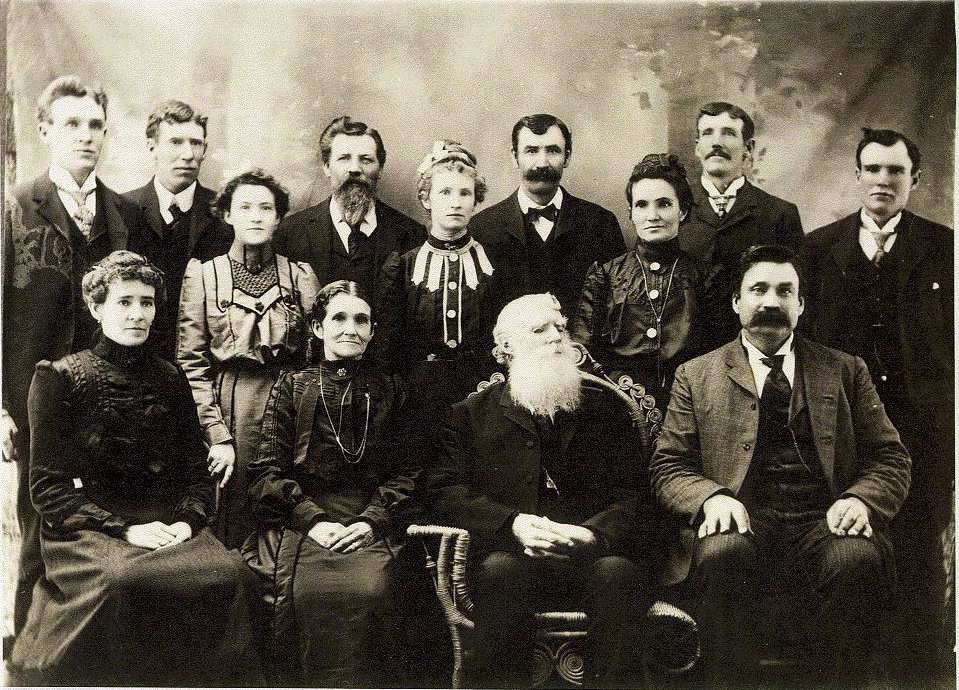
The David Buttars Family about 1905. Front: Elizabeth, Sarah, David,
and John S. Middle: Emma, Mary, and Lucy. Back: James, David A.,
Daniel, Robert, Charles, and Thomas.
Daniel served on the city council in 1910 and 1911 and was the road supervisor. He was a great man for the people of Clarkston. He was a real financier both for the people and himself. Things always seemed to come his way. The addition on the west side of the Church house and the expansion of the school were also projects he helped to promote. He was always ready to serve the town and help people.
Daniel's father, David Buttars died on November 23, 1911 at he age of eighty nine.
Daniel was the biggest stockman in Clarkston and always had the best; both in cattle and horses. He brought the first purebred horses into town. In 1913 Daniel, his half brother Tom, and Henry O. Thompson went to Iowa and bought purebred Percheron and Belgium horses and had them shipped to Logan. The horses were paraded about, then the horses were put up for sale.
Daniel and Tom shipped horses back to Omaha, Nebraska, for themselves and other farmers. They hired Clarkston boys to go on the train to care for the horses enroute. The horses had to be unloaded, fed, and watered along the way. The boys thought this was a privilege to see the country.
He also had several teams of horses for use on the farm. Each spring the harnesses were all taken apart and dipped into harness oil. This made the leather soft and pliable. The rough and dirty places were scraped and made smooth so they would not injure the horse's flesh. He also had several saddle horses. He liked to ride horses and his favorite pony's name was Sailor.
Daniel had a special gift for splicing and braiding rope. One of his specialties was securing a ring or snap in the end of a rope by braiding around it and back along the rope for several inches. He could splice a rope and make it almost as strong as it originally was. It was always done very neatly. Other people often brought braiding and splicing for him to do for them.
Another business venture he was involved with was a butcher shop that he and Tom Godfrey owned. There wasn't any refrigeration then and meat spoiled quickly in hot weather. They did not have it long before they sold it to Hyrum Holt in 1914.
The big two story house began to empty out by 1914, as more of the children went out on their own. Melvin, who had returned from his mission in 1912, married Agnes Jardine on January 7, 1914. Maybell married John H. Griffiths on January 28, 1914. And Orson married Elva Layne on June 17th of that same year. At that time, the five younger children were still living at home.
Daniel bought one of the first three cars that came into Clarkston. It was a
brand new 1915 Buick. Tom Buttars and David Dahle had the other two.
He was so used to horses that he called “whoa” to his car
when he wanted it to stop. At one time, he lost control of his car
and knocked out the boards in the end of the shed he was using for a
garage. He filled two sacks with dirt and placed them on the floor so
the car would stop when the front wheels ran up against them, in
order prevent another accident.
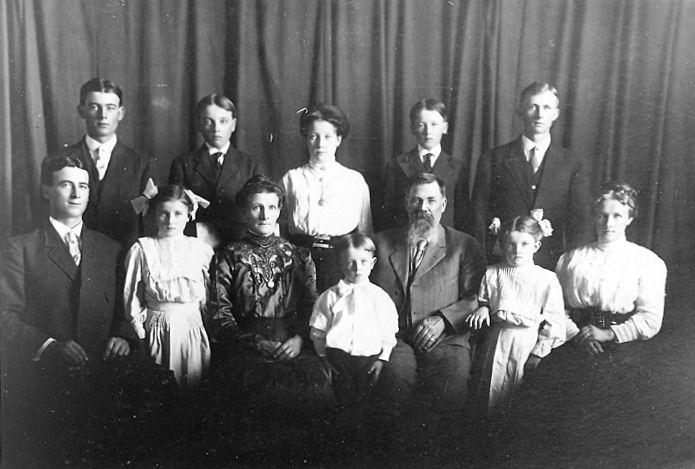
The Daniel Buttars Family Front row: Danny, Hattie, Emma, Wallace,
Daniel, Archulious, and Margaret. Back row: Orson, Gover, Maybell,
Iraw, and Melvin.
During the winter, he took the battery out of the car and stored it in the basement. The car was was stored in the barn until spring. It was jacked up and set on blocks with the wheels off the floor.
No one else in the family had learned to drive the car before he died. To know how to drive a car in 1915 was quite an accomplishment. Laurence Smith taught some of the boys to drive after his death.
Daniel was about 5 feet 9 inches tall. He was quite heavily built. He had an unusual large birthmark on his face. It was of a blue and purple color. It covered most of his cheek and one side of his nose. He always wore a full beard to cover it up. Later, when his health failed and he had to slow down because of heart trouble.
There was only one wedding in the family during 1915. On November 23rd Gover married Mary Eliza Godfrey in Preston. After that, there were only four children living at home.
Daniel Buttars died very suddenly of a heart attack at about 5:00 a.m. on 10 January 1916 at the age of fifty seven. He was setting in his big leather chair in front of the Heatrola and slipped out onto the floor. He and Emma were the only ones up that early. But it did not take long for the children who were still at home to get up when she called for them to go for help.
Clarkston, January 13, 1916
Funeral services over the remains of the late Daniel Buttars were held in the Ward Tabernacle on Wednesday at 2:00 p.m. The building was filled with relatives and friends from far and near. Services opened with the choir singing “Beautiful Home.” Elder Charles Shumway offered the invocation. Orin Myler sang that beautiful solo, “Sometime We'll Understand” accompanied by Hyrum S. Barson on the violin and Miss Lottie Jardine on the Organ.
Elder John E. Griffin of Newton spoke in glowing terms of the life and labors of the deceased in pioneering and building up the country and praised the family he had raised. He invited all to assist in consoling the bereaved widow, so sudden desolated.
Bishop Peterson of Trenton consoled the family and the community upon their great loss, but concluded that God knows best. Brother Buttars has well filled his mission and has been called elsewhere to further labors.
Mr. Vern Clark sang “Rock of Ages”. He was followed by Elder Thomas Griffin, who bore testimony to the remarks of the previous speakers. The town and valley had lost a valuable and progressive resident. One who used his means freely in building up all community interests, and who will be missed. He invoked the consolation of the Lord upon the widow and family.
Mrs. Laura Shumway and Miss Isadore Jardine sang “Sometime” in a most feeling manner, with Miss Lottie Jardine and Hyrum Barson as accompanists.
Elder Frank Shumway said that he had been on intimate terms with Brother Buttars and could testify that he was an honest man, also a most kindly one, always willing to donate his time and means to the service of the poor.
Closing remarks were made by Bishop Ravsten who referred to the deceased as a pillar in the ward in both civic and religious affairs. One of the latest general benefits was the splendid new water works. Throughout his life he has proven his faith by his works. He has been called hence to his sure reward.
The choir sang “God Be With You Till We Meet Again”. Counselor Thomas H. Griffin pronounced the benediction.
At the Clarkston Cemetery, to which a large cortège accompanied the remains. Bishop Ravsten's remarks were most profound and beautiful.
The pallbearers were his six stalwart sons, who with four daughters and the widow, and a host of relatives and friends are left to mourn a loss that never upon this earth can be replaced.
Peter S. Barson
There was a lot of snow that winter. Horse drwan sleighs were used in the funeral cortège. The casket was placed in the sleigh and covered with a quilt. Spring seats and boards were placed across other sleigh boxes for the family and friends to sit on. Daniel was buried in the Clarkston Cemetery on lot #13 place 1 - Block #6.
Daniel's estate was valued at about seventy five thousand dollars. It included eight hundred and fourty acres of farm land, a thousand thirty five acres of pasture land and close to one hundred head of farm animals. He did not have any life Insurance but he did have a lot of shares in worthless mining companies.
Of the four children living at home at the time of Daniel's death: Iraw married Gennie Dahle on October 1, 1918. Hattie married Owen Archibald on December 16, 1918. They were later divorced and she married Abram Hodges on December 16, 1942. Archulious married David N. Archibald on December 14, 1921. The last of the children to marry was Wallace on June 12, 1926 to Mary Eileen Clark. Gover's wife died in 1920 and Gover and his three children lived with Emma until Gover married Mary Harriett Bowles on June 28, 1922. Emma continued to live in their home for the next thirty six years and never remarried. She died on July 1, 1952.
The main source for this biography was the “Life Story of Daniel Buttars” written by his daughter, Archulious B. Archibald. Other pieces were taken from “History of the Life of Emma Gover Buttars” also written by Archulious B. Archibald and from “Clarkston: The Granary of Cache Valley”. The article about his funeral was written by Peter S. Barson for the Logan Journal.